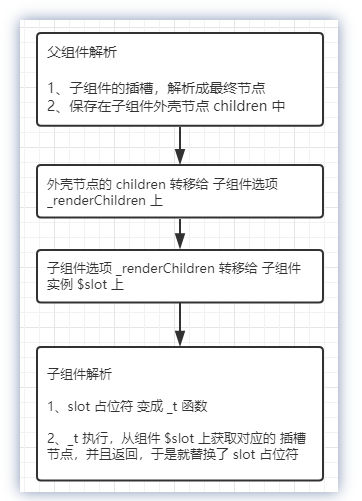vue slot的一点理解(1)
先来一个实例,方便解释:
子组件:
<template>
<div>
<button></button>
<slot>这里是默认值</slot>
<slot name="one">这里是默认值one</slot>
<slot name="two">这里是默认值two</slot>
<slot name="three">这里是默认值three</slot>
<slot name="dongdong" :value1="child1">这里是默认值1</slot>
</div>
</template>
父组件:
<template>
<div>
<p>这里是普通插槽,一个组件中只能有一个这种插槽</p>
<etbutton>{{ favalue }}</etbutton>
<p>这里是具名插槽,这里的v-slot可以简写为#one</p>
<etbutton>
<template>这里是插入到默认插槽的内容</template>
<template #one>这里是插入到one插槽的内容</template>
<template v-slot:two>这里是插入到two插槽的内容</template>
<template v-slot:three>这里是插入到three插槽的内容</template>
</etbutton>
<p>这里是作用域插槽</p>
<!-- 作用域插槽的实现步骤如下:
1.首先在子组件的的slot上面绑定一个值(:key = value)
2.然后在父组件中使用v-slot:name=变量,吧slot的值存到这变量中
-->
<etbutton>
<template v-slot:dongdong="slotdongdongval">{{
slotdongdongval.value1
}}</template>
</etbutton>
</div>
</template>
1.可以看到etbutton组件,相对父组件,他是一个子元素
2.其实,etbutton中的slot,他被当做etbutton组件的子元素
在vue渲染etbutton的时候,发现他不是一个常规的标签,认定他是一个组件之后,就会当做一个组件去解析。
父组件的vnode类似这样:
{
tag:'div',
children:[
{
tag:'test',
children:['我是放在组件的 slot 11']
}
]
}
当自定义组件渲染时候
if(如果是组件){
1initInternalComponent (vm, options);
}
initRender(vm);
走这里1initInternalComponent,然后吧test组件的插槽节点给了组件的选项的【_renderChildren】
function initInternalComponent(vm, options) {
// 这个options是全局选项和组件设置选项的合集
var opts = vm.$options =
Object.create(vm.constructor.options);
var componentOptions = parentVnode.componentOptions;
// 传给组件选项_renderChildren
opts._renderChildren = componentOptions.children;
}
源码我暂时研究不懂,知道有这么回事,不细说了。
注意一个过程:自定义组件,首先是需要实例初始化,然后用组件的模板(我理解就是vue文件吧),
去构建他的渲染函数。
什么是渲染函数:
with(this) {
return _c('main', [
"我在子组件里面",
_t("default")
], 2)
}





 浙公网安备 33010602011771号
浙公网安备 33010602011771号